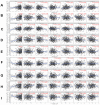Expression and molecular profiles of the AlkB family in ovarian serous carcinoma
- PMID: 33744868
- PMCID: PMC8064172
- DOI: 10.18632/aging.202716
Expression and molecular profiles of the AlkB family in ovarian serous carcinoma
Abstract
AlkB family of Fe (II) and α-ketoglutarate-dependent dioxygenases plays essential roles in development of ovarian serous carcinoma (OV). However, the molecular profiles of AlkB family in OV have not been clarified. The results indicated that the expression of ALKBH1/3/5/8 and FTO was lower in OV patients while ALKBH2/4/6/7 expression was higher. There was a strong correlation between ALKBH5/7 and pathological stage of OV patients. Kaplan-Meier plotter revealed that OV patients with high ALKBH4 level showed longer overall survival (OS). However, patients with high levels of ALKBH5/6 and FTO showed shorter OS and progression-free survival (PFS). Genetic alterations using cBioPortal revealed that the alteration rates of FTO were the highest. We also found that the functions of AlkB family were linked to several cancer-associated signaling pathways, including chemokine receptor signaling. TIMER database indicated that the AlkB family had a strong relationship with the infiltration of six types of immune cells (macrophages, neutrophils, CD8+ T-cells, B-cells, CD4+ T-cells and dendritic cells). Next, DiseaseMeth databases revealed that the global methylation levels of ALKBH1/2/3/4/5/6/7/8 and FTO were all lower in OV patients. Thus, our findings will enhance the understanding of AlkB family in OV pathology, and provide novel insights into AlkB-targeted therapy for OV patients.
Keywords: AlkB family; expression profiles; infiltrating immune cells; methylation; ovarian serous carcinoma.
Conflict of interest statement
Figures









Similar articles
-
ALKBH1-8 and FTO: Potential Therapeutic Targets and Prognostic Biomarkers in Lung Adenocarcinoma Pathogenesis.Front Cell Dev Biol. 2021 Jun 3;9:633927. doi: 10.3389/fcell.2021.633927. eCollection 2021. Front Cell Dev Biol. 2021. PMID: 34150745 Free PMC article.
-
The AlkB Family of Fe (II)/Alpha-Ketoglutarate-Dependent Dioxygenases Modulates Embryogenesis through Epigenetic Regulation.Curr Stem Cell Res Ther. 2018;13(2):136-143. doi: 10.2174/1574888X12666171027105532. Curr Stem Cell Res Ther. 2018. PMID: 29076432 Review.
-
The bioinformatics and experimental analysis of AlkB family for prognosis and immune cell infiltration in hepatocellular carcinoma.PeerJ. 2021 Sep 1;9:e12123. doi: 10.7717/peerj.12123. eCollection 2021. PeerJ. 2021. PMID: 34557360 Free PMC article.
-
YTH domain family: potential prognostic targets and immune-associated biomarkers in hepatocellular carcinoma.Aging (Albany NY). 2021 Nov 8;13(21):24205-24218. doi: 10.18632/aging.203674. Epub 2021 Nov 8. Aging (Albany NY). 2021. PMID: 34747720 Free PMC article.
-
ALKBHs-facilitated RNA modifications and de-modifications.DNA Repair (Amst). 2016 Aug;44:87-91. doi: 10.1016/j.dnarep.2016.05.026. Epub 2016 May 17. DNA Repair (Amst). 2016. PMID: 27237585 Free PMC article. Review.
Cited by
-
Research progress on m6A demethylase FTO and its role in gynecological tumors.Front Oncol. 2024 Aug 8;14:1413505. doi: 10.3389/fonc.2024.1413505. eCollection 2024. Front Oncol. 2024. PMID: 39175477 Free PMC article. Review.
-
Structural Analysis of the AlkB Family in Poultry.Animals (Basel). 2025 Jul 1;15(13):1942. doi: 10.3390/ani15131942. Animals (Basel). 2025. PMID: 40646842 Free PMC article.
-
The biological function of demethylase ALKBH1 and its role in human diseases.Heliyon. 2024 Jun 24;10(13):e33489. doi: 10.1016/j.heliyon.2024.e33489. eCollection 2024 Jul 15. Heliyon. 2024. PMID: 39040364 Free PMC article. Review.
-
The role of RNA methylation in tumor immunity and its potential in immunotherapy.Mol Cancer. 2024 Jun 20;23(1):130. doi: 10.1186/s12943-024-02041-8. Mol Cancer. 2024. PMID: 38902779 Free PMC article. Review.
-
Downregulated exosome-associated gene FGF9 as a novel diagnostic and prognostic target for ovarian cancer and its underlying roles in immune regulation.Aging (Albany NY). 2022 Feb 21;14(4):1822-1835. doi: 10.18632/aging.203905. Epub 2022 Feb 21. Aging (Albany NY). 2022. PMID: 35190498 Free PMC article.
References
Publication types
MeSH terms
Substances
LinkOut - more resources
Full Text Sources
Other Literature Sources
Medical
Research Materials

